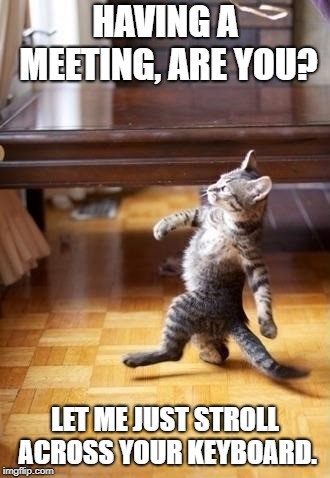The ideal meeting is rare, like cake-only diets or honest politicians. We’ve talked previously about how meetings are rubbish and counter-productive, but how do you actually have a good meeting when you can’t avoid one?
Clients, bosses and colleagues all ask for them at some point. And you’ve stood firm before. But sooner or later, you’ll be swindled into the meeting room with promises of efficiency, collaboration and progress. Happy families, happy company. The reality is usually faffing, doodling and wandering down the garden path.
It’s time for a change. Here are 10 steps on how to run the perfect meeting.
1. Define your goals
What is the meeting about? What does ‘success’ look like?
If you want to report on a project, then you probably have a strict plan involving a 10-minute presentation for mains and a smattering of questions for dessert. If the meeting is for coming up with ideas for a project, you must allow for a more free-flowing buffet-style structure. You have to be flexible.
So, is the meeting for:
- A regular progress update so everyone can be certain that, yes, work is happening?
- Analysing data reports and preventing client panic?
- Coming up with brilliant ideas?
- Problem-solving something messy and complex?
- Selling a shiny object to someone?
- Presenting something clever with the big board and the fun laser pointer thing?
- An employee review or one-to-one?
- Compromising your work-time for the sake of appeasing other people, like big, bad bosses, a.k.a. ‘picking your battles’?
- Socialising, improving relationships and ‘team-building’ (sorry)?
- A duel? Dawn. Swords.
2. Pick your time
Getting people together for a meeting can be a bit like herding cats. But, if you want them to really engage, try to have your meeting when everyone is most likely to be awake and prepared. 9.30 or 10am is pretty good, since by then, the coffee’s probably kicked in. Avoid Fridays. Don’t catch people during the post-lunch stupor.
And, make sure to give everyone advanced notice. Nothing like an unexpected meeting to throw a spanner in their carefully laid plans.
3. Make an agenda
An agenda gives your meeting focus. Even if ‘everyone knows’ what the meeting is about, it’s still worth having those talking points down on paper.
The agenda should be sent out well in advance. At least, either the day before the meeting if it’s a morning meeting, or on the morning of the day the meeting is happening, if it’s later on in the afternoon.
4. Share the agenda
Take the agenda as an opportunity to collate talking points. If you find yourself constantly answering emails throughout the week, train those pesky emailers in the way of the agenda. Even if – at first – it means having a conversation like this:
‘Could you just answer this question?’
‘Absolutely. I’ve put it on the agenda for Monday’s meeting.’
‘Ah but it’s just a quick one.’
‘Awesome. It’s on the agenda.’
‘It’s urgent.’
‘Is it more urgent than the other things you’ve asked me to do this week?’
‘No.’
‘See you Monday.’
Trust us. One quick question always turns into several back-and-forth questions, and suddenly you’ve lost a precious hour to the email vortex.
It might even be an idea to have a collaborative document for everyone to write down things they’d like to bring up. We use Dropbox Paper.
5. Tell people if they need to prepare
Unless you’re just delivering a lecture, a meeting is meant to foster collaboration. Otherwise, it should’ve been an email. If other people need to prepare for a meeting ahead of time, make sure you know where that work stands beforehand.
Nothing like ‘oh I meant to do that’ to render a whole meeting pointless. At least if you know something hasn’t been done you can reschedule the meeting.
6. Leave time for settling in
The first five to ten minutes is dead time. People might turn up a few minutes late, they might need to get a drink, and whoever’s setting up the PowerPoint is certainly bound for a few minutes of exasperated fumbling.
We’ve all been there.
As a remote-working business, at Articulate we often have teleconference meetings, which can come with their own set of issues, like tangled headphones, patchy audio and background noise.

7. Steer the ship
Once the meeting begins, it can quickly end up on the rocks of casual banter or lost in the estuaries of griping about customers. If you’re running the meeting it’s up to you to steer the conversation in the right direction.
Don’t be too hard-handed, though. People have a roundabout way of getting to the point sometimes, but that process can bear some unexpected rewards.
8. Promise nothing
It’s easy to please.
Some management coach told you never to say ‘maybe’ or ‘I don’t know’ in front of a client or boss. However, making promises that you later have to amend, or – worse – work hours and hours of overtime to accomplish, is not the way to go. Neither party will be happy, and the work will suffer.
If you want a long-term relationship with your clients, bosses or team, you need to avoid hastily-made promises. A definite ‘maybe’ is better than an uncertain ‘yes’.
9. Have someone take notes
Avoid whodunnits.
If you’re running the meeting, have a colleague take notes, if you can. You can send these notes out to everyone or keep them for your own reference. Not only will it help keep everyone accountable, but it will ensure nothing important gets forgotten.
10. Give clear marching orders
Nothing like mutual misunderstanding to round off a good meeting. Ensure everyone at the meeting knows what jobs need doing going forward. It helps to send a quick follow-up email with ‘to-do’s if there are a lot, especially if, like us, you are working from home. And, schedule some time after a meeting so you can follow-up on anything you need to do as well. Back-to-back meetings don’t make for a productive day.
As The Scottish Play goes:
When shall we three meet again?
In thunder, lightning, or in rain?
How ‘bout Tuesday?
… or something like that…






